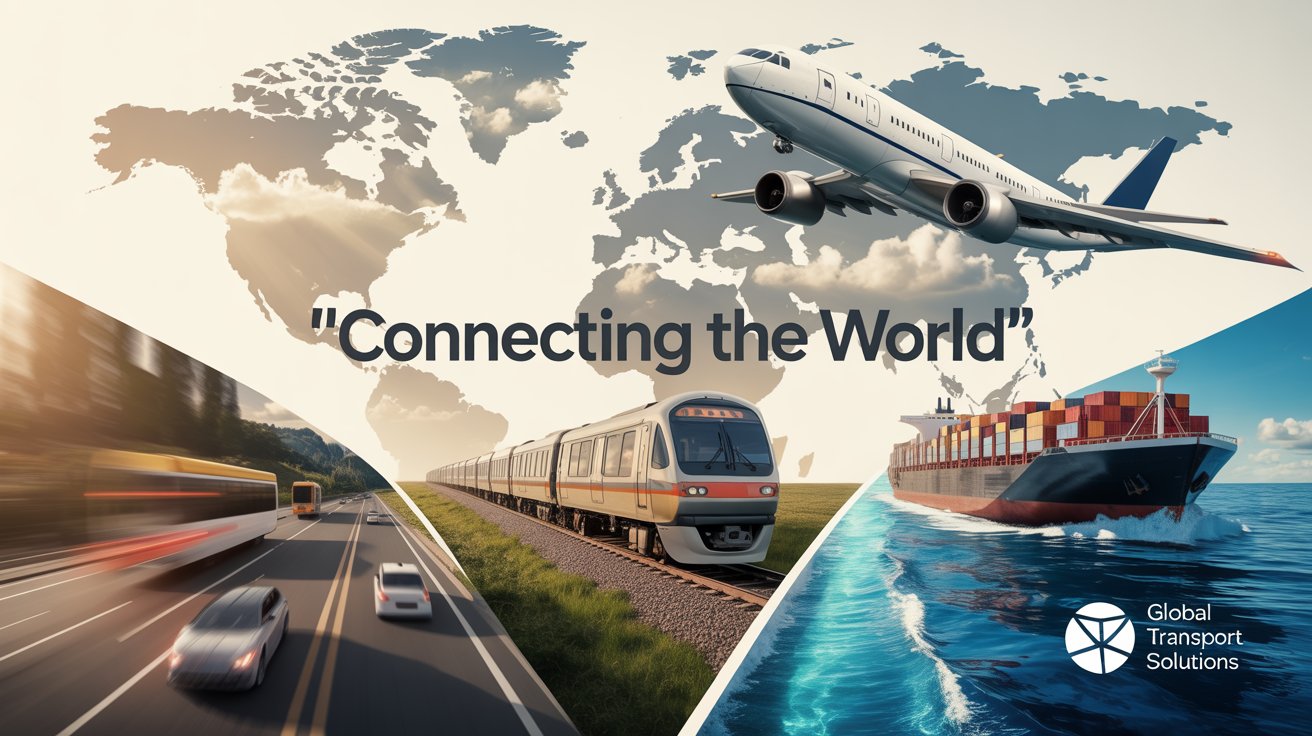
What are the 4 Types of Transportation: Explore Now
Have you ever stopped to think about how you get from one place to another? The world around you is constantly in motion, and transportation plays a crucial role in connecting you with everything you need.
Whether you're commuting to work, planning a vacation, or simply heading to the grocery store, understanding the different types of transportation can help you make smarter, more efficient choices. You'll discover the four main types of transportation that keep you moving forward, each with its own unique benefits and challenges.
Get ready to explore the fascinating world of transportation and uncover which option might be the best fit for your lifestyle. Keep reading, and you'll gain insights that could change the way you travel forever!
Land Transportation
Transportation plays a crucial role in our daily lives, connecting people, goods, and services across the globe. There are four main types of transportation: land, water, air, and pipeline. Among these, land transportation is the most common and widely used. It includes vehicles that travel on roads and rails, making it a vital part of our infrastructure. Let's delve into the two major components of land transportation: road transport and rail transport.
Road Transport
Road transport is one of the most accessible forms of transportation. It is used by millions of people every day. This type of transport involves vehicles such as cars, buses, trucks, and motorcycles. It is essential for short-distance travel and urban commuting.
Key features of road transport include:
Flexibility: Road transport provides flexibility in terms of route and timing.
Door-to-door service: It allows for direct delivery of goods and personal travel.
Cost-effectiveness: For short distances, it is often more economical than other modes.
Here's a simple comparison of some common road vehicles:
Despite its benefits, road transport faces challenges like traffic congestion and environmental impact. Solutions such as carpooling and electric vehicles are being explored to address these issues.
Rail Transport
Rail transport is another significant part of land transportation. It is known for its efficiency and ability to move large numbers of people and goods over long distances. Trains are the primary vehicles used in rail transport, running on tracks that span countries and continents.
Advantages of rail transport include:
High capacity: Trains can carry more passengers and freight compared to road vehicles.
Energy efficiency: Trains use less energy per ton-mile than road vehicles.
Reliability: Rail schedules are often more predictable.
Rail transport is crucial for freight movement, especially for heavy and bulk items like coal, steel, and grain. It also plays a key role in public transportation through commuter and intercity trains.
Here is a quick look at some rail transport types:
While rail transport is efficient, it requires significant infrastructure investment. Improvements in rail technology continue to enhance its role in the global transportation network.
Water Transportation
Transportation shapes our world. It connects places and people, moving goods and services. There are four main types: land, air, rail, and water. Water transportation uses oceans, rivers, and lakes. It's an ancient method, still vital today. Whether shipping goods or ferrying people, water transportation plays a crucial role in global trade and travel.
Shipping
Shipping is a cornerstone of water transportation. It moves large quantities of goods worldwide. Think of massive container ships crossing oceans. These ships carry everything from electronics to food.
Here are some key aspects of shipping:
Efficiency: Ships can carry thousands of containers at once.
Cost-effective: Shipping is cheaper than air transport for bulk goods.
Environmental impact: Though efficient, ships contribute to pollution.
Shipping companies often use logistical strategies to optimize routes. They balance speed and cost, choosing the best path across seas. Here's a brief comparison:
Shipping remains essential for international trade. It connects markets and drives economies.
Ferries
Ferries offer another form of water transportation. They move people and vehicles across water. Ferries are common in coastal areas and islands. They provide vital links where bridges are impractical.
Ferries have several benefits:
Accessibility: They connect remote locations.
Convenience: Ferries can carry passengers and cars.
Scenic travel: Enjoy beautiful views during the journey.
Ferries operate on regular schedules. They serve tourists and locals alike. Some ferries offer services like dining or cabins for longer trips. Here's what you might find on a ferry:
Passenger seating
Vehicle decks
Snack bars
Ferries are a practical choice for short distances. They enhance travel experiences with comfort and ease.
Air Transportation
Transportation is a crucial part of modern life, connecting people and goods across distances. It includes four main types: land, water, air, and rail. Each type offers unique benefits and serves different purposes. Air transportation is one of the fastest ways to travel. It allows people and cargo to move quickly across the globe. This type of transportation is essential for international travel and trade. It plays a vital role in the global economy.
Commercial Flights
Commercial flights are the most common form of air transportation. They carry passengers across domestic and international routes. Airlines operate these flights, providing regular schedules and services. The main advantages include speed and convenience. Travelers can reach distant locations in hours, not days.
Comfort: Airlines offer various seating options, from economy to first-class.
Safety: Modern aircraft are equipped with advanced safety features.
Connectivity: Airports connect flights, making global travel possible.
Airlines compete by offering better services and lower prices. Frequent flyer programs reward loyal customers with discounts and perks. Commercial flights help boost tourism, business, and cultural exchange. They connect cities and countries, facilitating global interaction.
Cargo Flights
Cargo flights are dedicated to transporting goods, not passengers. They play a crucial role in global trade. These flights carry everything from electronics to food. Cargo airlines specialize in handling large volumes of shipments.
Efficiency: Cargo flights offer rapid delivery of goods across continents.
Capacity: Airplanes can carry bulky and heavy items.
Reliability: Scheduled operations ensure timely deliveries.
Businesses depend on cargo flights for supply chain management. They ensure products reach markets quickly. Cargo flights use specialized aircraft with larger cargo holds. Some passenger airlines also transport cargo in the belly of the plane.
Air freight is more expensive than sea or land freight but faster. It is ideal for time-sensitive shipments, such as medical supplies. Cargo flights support e-commerce by enabling quick delivery of online orders worldwide. They contribute significantly to economic growth and globalization.
Pipeline Transportation
Transportation is essential for moving goods and people from one place to another. There are four main types: road, rail, air, and pipeline. Each has its own uses and benefits. In this section, we will explore Pipeline Transportation. This method is vital for moving liquids and gases over long distances.
What Is Pipeline Transportation?
Pipeline transportation uses pipes to carry liquids and gases. It is most common for oil, natural gas, and water. The pipelines are buried underground or laid on the ocean floor. This makes them safe and secure.
Advantages Of Pipeline Transportation
Cost-Effective: Once built, pipelines are cheaper to operate than other methods.
Safe and Reliable: Pipelines reduce the risk of accidents compared to trucks or trains.
Environmental Impact: Pipelines have a lower carbon footprint. They use less fuel and reduce emissions.
Challenges In Pipeline Transportation
Despite its benefits, there are challenges. Building pipelines can be expensive and requires planning. Here are some key challenges:
Construction Costs: Building pipelines over long distances is costly.
Environmental Concerns: Pipelines may affect wildlife and natural habitats.
Maintenance: Regular checks are needed to prevent leaks and damage.
Common Uses Of Pipeline Transportation
Comparative Advantages
Transportation is a vital part of our daily lives. It helps people and goods move from one place to another. There are four main types: road, rail, air, and water transportation. Each type has its own advantages. Understanding these can help us choose the best option for our needs. Let's dive into the comparative advantages of each transportation type.
Road Transportation
Road transportation is very flexible. It allows door-to-door service, making it convenient for short distances. Cars, trucks, and buses are common examples. A key advantage is the ability to travel at any time. This makes road transport ideal for personal and local delivery needs.
Accessibility: Roads connect even remote areas.
Flexibility: Travel schedules can be customized.
Cost-effectiveness: Cheaper for short distances.
Rail Transportation
Rail transportation is known for its efficiency. Trains can carry large amounts of goods and people over long distances. They are less affected by weather conditions compared to road transport. This makes rail transport reliable for bulk shipping.
Capacity: Can transport large volumes.
Consistency: Timetables are usually fixed.
Eco-friendly: Lower emissions per ton-mile.
Air transportation is the fastest among all. It is perfect for long-distance travel and urgent shipments. Although more expensive, air transport saves time. It connects countries and continents efficiently.
Speed: Fastest mode available.
Reach: Global connectivity.
Safety: High safety standards.
Water transportation is ideal for moving large quantities over long distances. Ships and boats are the main vehicles. It is cost-effective for international trade. Though slower, it is reliable for non-urgent shipments.
Capacity: Ideal for bulky goods.
Economy: Lower costs over long distances.
Sustainability: More energy-efficient.
Environmental Impact
Transportation is essential for daily life, connecting people, goods, and services. It shapes how we live and work. But it also affects our planet. Understanding the environmental impact of different transportation types helps us make better choices for the earth. There are four main types of transportation: road, rail, air, and water. Each one has unique effects on the environment.
Environmental Impact Of Road Transportation
Road transportation uses cars, buses, and trucks. It's the most common way to travel. But it has a big environmental cost. Vehicles burn fossil fuels, releasing carbon dioxide into the air. Air pollution from cars contributes to global warming. It also causes health problems for people who breathe polluted air. Noise pollution from traffic affects both humans and wildlife.
High greenhouse gas emissions.
Significant noise pollution.
Air quality degradation.
Environmental Impact Of Rail Transportation
Rail transportation is often seen as a greener option. Trains can carry many people and goods at once, reducing emissions per person. Electric trains are even cleaner because they don't burn fossil fuels. But building railways can affect natural habitats. Railways sometimes cut through forests and fields, disrupting ecosystems.
Environmental Impact Of Air Transportation
Air travel is fast but harmful to the environment. Planes use a lot of fuel, emitting greenhouse gases. These emissions contribute to climate change. Airports also need large areas of land, affecting local ecosystems. Noise from planes can disturb both people and wildlife.
High fuel consumption.
Significant greenhouse gas emissions.
Noise pollution.
Environmental Impact Of Water Transportation
Water transportation includes ships and boats. It's efficient for moving large quantities of goods. But ships often use heavy fuel oil, which pollutes the air and water. Oil spills can harm marine life and ecosystems. Noise from large ships can affect underwater wildlife.
Efficient for bulk transport.
Heavy fuel oil usage.
Risk of oil spills.
Technological Innovations
Transportation has evolved significantly over the years, and technological innovations have played a crucial role in this transformation. Today, we see advancements across various modes of transport, enhancing speed, safety, and efficiency. These innovations not only change how we travel but also impact global economies and cultures. Let's explore some of the latest developments in transportation technology.
Air travel has seen remarkable technological innovations. Modern aircraft are now equipped with advanced navigation systems, reducing flight times and enhancing safety. New materials, such as carbon composites, make planes lighter, improving fuel efficiency. The development of electric airplanes promises a cleaner and quieter future in air travel.
Land transportation has witnessed significant technological advancements. Electric vehicles are becoming more common, offering eco-friendly alternatives to traditional cars. Autonomous vehicles, guided by sophisticated AI systems, promise safer roads. High-speed rail systems are redefining long-distance travel, providing fast and efficient service.
Water transport is benefiting from new technology as well. Ships are now powered by cleaner fuels like LNG, reducing environmental impact. Smart navigation systems ensure safer and more efficient routing. Innovations in hull design and materials improve speed and fuel efficiency, making shipping more cost-effective.
Space Transportation
Space travel is no longer a distant dream. New technologies are making it possible. Reusable rockets are reducing the cost of space travel significantly. Advances in propulsion systems are allowing for faster journeys. Space tourism is on the horizon, promising to take passengers beyond Earth.
Economic Factors
Transportation plays a vital role in shaping the economy. It connects businesses, people, and regions, facilitating trade and commerce. Understanding the economic factors behind different types of transportation can help optimize choices for cost-effectiveness and efficiency.
Economic Factors Impacting Road Transportation
Road transportation is flexible and accessible. It offers door-to-door delivery but faces costs like fuel, maintenance, and tolls. Fuel prices can significantly impact transportation costs. Economic conditions can influence vehicle prices, insurance rates, and repair expenses. Road networks require investment, affecting local and national budgets.
Economic Factors Impacting Rail Transportation
Rail transportation is efficient for long distances and bulk goods. It boasts lower costs per ton-mile compared to road transport. Infrastructure investment is critical; railways need maintenance and expansion to support economic growth. Ticket prices and freight charges depend on economic factors like energy costs and labor rates.
Economic Factors Impacting Air Transportation
Air transportation is fast but costly. Fuel prices and airport fees are major economic factors. Ticket pricing is influenced by demand and competition. Airlines face economic challenges like fluctuating fuel costs and taxation, affecting profitability. Investments in technology can optimize operations and reduce economic burdens.
Economic Factors Impacting Water Transportation
Water transportation is ideal for heavy and bulk goods. It benefits from low costs per ton-mile. Port fees and ship maintenance are economic considerations. Global trade impacts this sector significantly. The economic climate can affect shipping rates and the availability of routes, influencing economic viability.
Future Trends
Transportation shapes how we live, work, and play. The four types of transportation are road, rail, air, and water. Each mode offers unique benefits and challenges. With technology evolving, future trends promise to transform these systems. From electric vehicles to smart ships, we are on the verge of significant changes. Let's explore what the future holds for each transportation type.
Road Transportation
Road transportation is changing fast. Electric vehicles are becoming popular. They reduce pollution and save fuel costs. Self-driving cars could be the next big step. They promise safer journeys and less traffic. Smart roads might connect with these vehicles, offering real-time updates and efficient routes.
Rail Transportation
Rail systems are evolving with high-speed trains. These trains cut travel time and improve connectivity. Maglev trains use magnetic forces to move. They offer smoother rides and less noise. Automated rail systems are also in the pipeline. They could handle operations without human intervention.
Electric planes are emerging as a green option.
Drone taxis might soon fly us around cities.
Supersonic jets could shorten long flights.
Air travel is set to become faster and more efficient. These innovations aim to make flights eco-friendly and quicker.
Ships and boats are not left behind. Electric ferries are gaining interest. They offer clean and quiet rides. Autonomous cargo ships could soon navigate the oceans. They promise safer and more efficient transport. Smart shipping containers might track goods, ensuring timely deliveries.
Future trends in transportation promise exciting possibilities. These innovations aim for greener, safer, and more efficient systems. With technology advancing rapidly, the transportation landscape is set to change dramatically.
Global Connectivity
Transportation is the backbone of global connectivity. It allows for movement and interaction across vast distances. The four types of transportation — air, land, sea, and rail — each play a crucial role in connecting people and goods worldwide. Understanding these types can help us appreciate how interconnected our world truly is. Let's explore how each type contributes to global connectivity.
Air travel is the fastest way to connect distant places. It shrinks continents and oceans, making global travel possible in hours rather than days. Airlines operate thousands of flights daily, linking cities across the world. This connectivity boosts international trade and tourism.
Speed: Aircrafts travel at high speeds, reducing travel time.
Reach: Airports are found in almost every major city.
Efficiency: Ideal for long-distance travel.
Land transportation includes cars, buses, and trucks. It is vital for local and regional connectivity. Roads and highways enable easy movement between towns and cities. This type of transportation plays a key role in distributing goods and commuting.
Sea Transportation
Sea transport is crucial for international trade. Ships move large quantities of goods across oceans. Ports serve as gateways for imports and exports, enhancing economic connectivity. Sea transportation is energy-efficient for bulk goods.
Shipping: Moves goods in large volumes.
Fishing: Connects coastal communities.
Cruises: Promotes leisure travel.
Rail Transportation
Railways connect cities and countries over land. Trains offer a balance between speed and capacity. They are essential for freight and passenger travel. Rail networks span continents, linking rural and urban areas seamlessly.
Freight Trains: Transport heavy and bulk goods.
Passenger Trains: Affordable and efficient travel.
Subways: Urban transit solutions.
Frequently Asked Questions
What Are The 4 Different Types Of Transportation?
The four types of transportation are road, rail, air, and water. Road transportation includes cars and buses. Rail involves trains and subways. Air transportation features airplanes and helicopters. Water transportation includes ships, boats, and ferries. Each mode offers unique benefits for various travel and freight needs.
What Are The 4 Elements Of Transport?
The four elements of transport are the vehicle, infrastructure, operations, and energy. Vehicles move goods or people. Infrastructure includes roads, railways, and airports. Operations involve management and logistics. Energy powers the transport system. Understanding these elements ensures efficient and sustainable transportation solutions.
What Are The 5 Modes Of Transportation?
The five modes of transportation are road, rail, air, water, and pipeline. Road includes cars and buses. Rail involves trains. Air covers airplanes and helicopters. Water consists of ships and boats. Pipelines transport liquids and gases over long distances efficiently.
Each mode serves different needs and distances.
Conclusion
Understanding transportation types is vital for everyday life. Each type serves unique needs. Road transport is flexible and accessible. Railways offer speed and efficiency over long distances. Air travel connects distant places quickly. Water transport is essential for global trade.
Choosing the right mode depends on various factors. Consider distance, cost, and urgency. This knowledge helps in planning travel or shipments effectively. It also enhances awareness of environmental impacts. Always weigh your options wisely. Efficient transportation improves life quality. Stay informed and make smart decisions.


